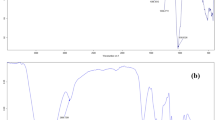Abstract
Further studies using scanning electron microscopy/energy dispersive X-ray analysis (SEM/EDX), micro-Fourier transform infrared spectroscopy (FTIR), X-ray photoelectron spectroscopy (XPS) and solid state magic angle spinning nuclear magnetic resonance (MAS NMR) techniques of calcium phosphate growth on Ca(OH)2-treated urea/H3PO3- and urea/H3PO4-modified cotton fibres are reported. In the case of the Ca(OH)2-treated urea/H3PO3-modified fibres which have been reported in an earlier paper, further experiments subjecting the urea/H3PO3-modified cotton to alternative soaking treatment procedures to Ca(OH)2 as well as different calcium phosphate growth media such as the alkaline phosphatase-catalysed hydrolysis of disodium p-nitrophenylphosphate to free phosphate have reaffirmed the importance of the Ca(OH)2 treatment step for the stimulus and growth of calcium phosphate growth on the fibres. Studies on cotton phosphorylated by a slightly different method using urea/H3PO4 instead of urea/H3PO3 show that a phosphorylated cotton with similar properties to the urea/H3PO3-modified fibres can be produced. Soaking of these fibres in saturated Ca(OH)2 solution leads to cotton coated with thin layers of calcium phosphate formed by partial hydrolysis of the PO4 functionalities in the phosphorylated cotton which are believed to act as nucleation layers for further calcium phosphate deposition when the fibres are subsequently soaked in 1.5×SBF solution. SEM/EDX studies of the calcium phosphate coatings formed on the Ca(OH)2-treated urea-H3PO4 fibres as a function of soaking time in 1.5 × SBF show that coatings deposit and become noticeably thick after approximately 9 days. XPS studies indicated the presence of carbonate species in the calcium phosphate coating deposited. In common with the calcium phosphate coated Ca(OH)2-treated urea/H3PO3-modified fibres studied earlier, the average EDX-measured Ca: P ratios of the coatings formed on the Ca(OH)2-treated urea/H3PO4 fibres are ∼ 1.60 and give very similar micro-FTIR spectra with evidence of carbonate which suggests that amorphous calcium deficient apatite has deposited.
Similar content being viewed by others
References
M. R. MUCALO, Y. YOKOGAWA, M. TORIYAMA, T. SUZUKI, Y. KAWAMOTO, F. NAGATA and K. NISHIZAWA, J. Mater. Sci. Mater. Med.
H. AOKI, in “Medical applications of hydroxyapatite” (Ishiyaku EuroAmerica Inc. Tokyo, St Louis, 1994) p. 114.
M. R. MUCALO, M. TORIYAMA, Y. YOKOGAWA, T. SUZUKI, Y. KAWAMOTO, F. NAGATA and K. NISHIZAWA, J. Mater. Sci. Mater. Med. in press.
A. HIRAI, F. HORII and R. KITAMARU, Bull. Inst. Chem. Res., Kyoto Univ. 63 (1985) 340.
F. ABBONA and M. FRANCHINI-ANGELA, J. Crystal Growth 104 (1990) 661.
J. F. JURGENS, J. D. REID and J. D. GUTHRIE, J. Textile Res. 18 (1948) 42.
A. T.-C. WONG and J. T. CZERNUSZKA, Colloids and Surfaces A: Physicochemical and Engineering Aspecis 78 (1993) 245.
Author information
Authors and Affiliations
Rights and permissions
About this article
Cite this article
Mucalo, M.R., Yokogawa, Y., Suzuki, T. et al. Further studies of calcium phosphate growth on phosphorylated cotton fibres. J Mater Sci: Mater Med 6, 658–669 (1995). https://doi.org/10.1007/BF00123448
Received:
Accepted:
Issue Date:
DOI: https://doi.org/10.1007/BF00123448




